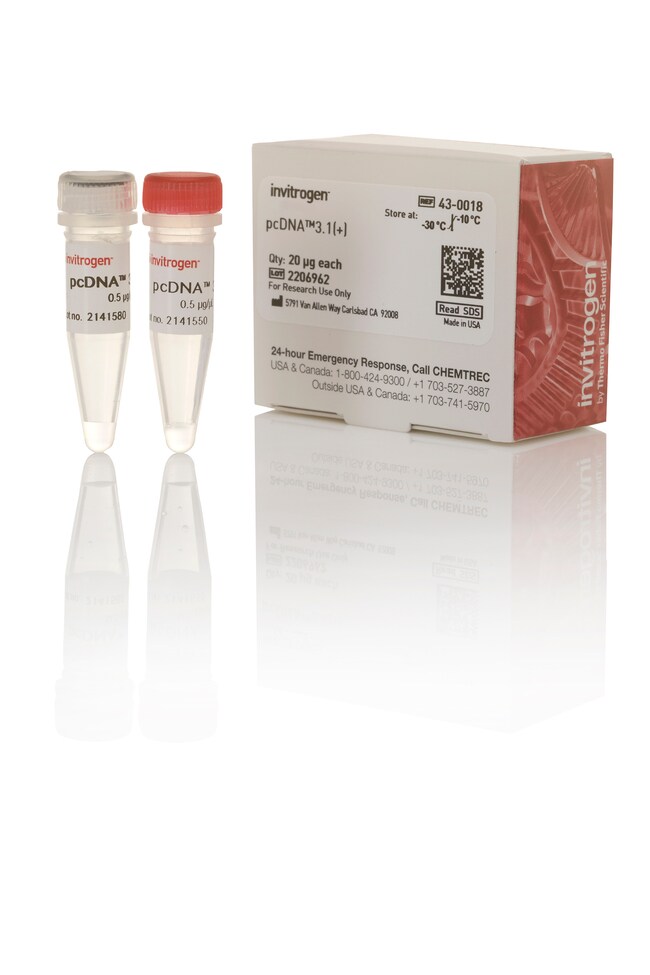Search Thermo Fisher Scientific

pcDNA™3.1 (+) Mammalian Expression Vector
 Promotion
Promotion Promotion
Promotion| Catalog Number | Quantity |
|---|---|
V79020 | 20 μg |
The pcDNA™3.1 Expression Vector Family
Three untagged versions of pcDNA™3.1 (available separately), each with a different selectable marker (Geneticin™, Zeocin™, or Hygromycin), are for use alone or in co-transfections. All three vectors offer the following features:
• Cytomegalovirus (CMV) enhancer-promoter for high-level expression
• Large multiple cloning site in either forward (+) or reverse (-) orientations
• Bovine Growth Hormone (BGH) polyadenylation signal and transcription termination sequence for enhanced mRNA stability
• SV40 origin for episomal replication and simple vector rescue in cell lines expressing the large T antigen (i.e., COS-1 and COS-7)
• Ampicillin resistance gene and pUC origin for selection and maintenance in E. coli
Customers who viewed this item also viewed
Documents & Downloads
Certificates
Safety Data Sheets
Vector Information
Scientific Resources
Product Information
Frequently asked questions (FAQs)
Here are possible causes and solutions:
Detection method may not be appropriate or sensitive enough:
- We recommend optimizing the detection protocol or finding more sensitive methods. If the protein is being detected by Coomassie/silver staining, we recommend doing a western blot for increased sensitivity. The presence of endogenous proteins in the lysate may obscure the protein of interest in a Coomassie/silver stain. If available, we recommend using a positive control for the western blot.
- Insufficient number of clones screened: Screen at least 20 clones.
- Inappropriate antibiotic concentration used for stable selection: Make sure the antibiotic kill curve was performed correctly. Since the potency of a given antibiotic depends upon cell type, serum, medium, and culture technique, the dose must be determined each time a stable selection is performed. Even the stable cell lines we offer may be more or less sensitive to the dose we recommend if the medium or serum is significantly different.
- Expression of gene product (even low level) may not be compatible with growth of the cell line: Use an inducible expression system.
- Negative clones may result from preferential linearization at a vector site critical for expression of the gene of interest: Linearize the vector at a site that is not critical for expression, such as within the bacterial resistance marker.
Here are possible causes and solutions:
- Try the control expression that is included in the kit
Possible detection problem:
- Detection of expressed protein may not be possible in a transient transfection, since the transfection efficiency may be too low for detection by methods that assess the entire transfected population. We recommend optimizing the transfection efficiency, doing stable selection, or using methods that permit examination of individual cells. You can also increase the level of expression by changing the promoter or cell type.
- Expression within the cell may be too low for the chosen detection method. We recommend optimizing the detection protocol or finding more sensitive methods. If the protein is being detected by Coomassie/silver staining, we recommend doing a western blot for increased sensitivity. The presence of endogenous proteins in the lysate may obscure the protein of interest in a Coomassie/silver stain. If available, we recommend using a positive control for the western blot.
Protein might be degraded or truncated: Check on a Northern.
Possible time-course issue: Since the expression of a protein over time will depend upon the nature of the protein, we always recommend doing a time course for expression. A pilot time-course assay will help to determine the optimal window for expression.
Possible cloning issues: Verify clones by restriction digestion and/or sequencing.
Find additional tips, troubleshooting help, and resources within our Protein Expression Support Center.
No; neomycin is toxic to mammalian cells. We recommend using Geneticin (a.k.a. G418 Sulfate), as it is a less toxic and very effective alternative for selection in mammalian cells.
Translation initiation will occur at the first ATG encountered by the ribosome, although in the absence of a Kozak sequence, initiation will be relatively weak. Any insert downstream would express a fusion protein if it is in frame with this initial ATG, but levels of expressed protein are predicted to be low if there is a non-Kozak consensus sequence. If the vector contains a non-Kozak consensus ATG, we recommend that you clone your gene upstream of that ATG and include a Kozak sequence for optimal expression.
pcDNA3.1 vectors contain the core CMV promoter that is truncated before the start of transcription, whereas the pcDNA 3.3-TOPO vector has the 672 bp native CMV promoter. This native CMV promoter allows high-level gene expression with two- to five-fold higher protein yields compared to other expression vectors. pcDNA3.1 vectors are available in restriction, TOPO, and Gateway cloning versions and as untagged and epitope-tagged versions, whereas the pcDNA3.3-TOPO vector is a TOPO TA-adapted, untagged vector that can be used to express native proteins without extraneous amino acids, and is hence ideal for antibody production and structural biology.